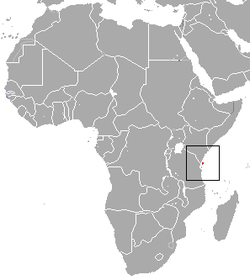Status
The IUCN lists this bat as being "Vulnerable. Its range is limited to the island of Pemba off the coast of Tanzania and it is traditionally hunted for food. This hunting became unsustainable when shotguns began to be used. Another threat to the bats is the ongoing destruction of their forest habitat. [1]
During the early 1990s there were only a few hundred individuals remaining. Conservation measures implemented by the Forestry Department on Pemba include an education campaign, the establishment of wildlife clubs to protect nearby roosts, and continuous monitoring of the population. Also, the hunting of these bats with shotguns is now banned on most of the island. The local population has been involved in conservation measures and bat-based ecotourism is producing extra revenue for the island. With these measures in place, the number of bats has increased and by 2007 there were estimated to be about 20,000. The population appears to have continued to increase, with numbers nearing 29,000 in 2011. [1]
This page is based on this
Wikipedia article Text is available under the
CC BY-SA 4.0 license; additional terms may apply.
Images, videos and audio are available under their respective licenses.


